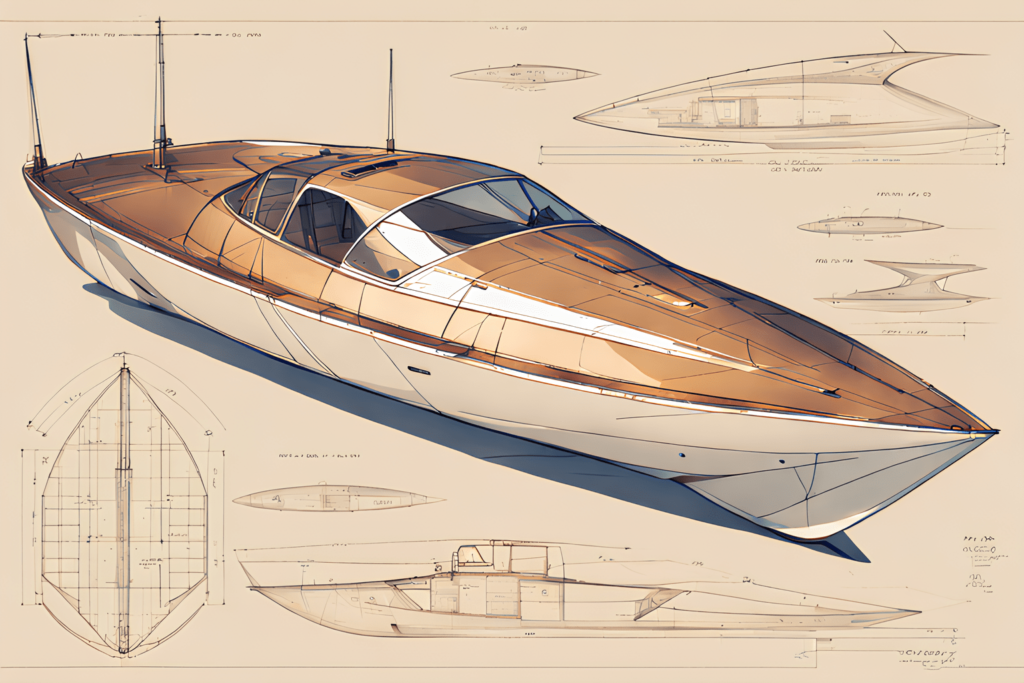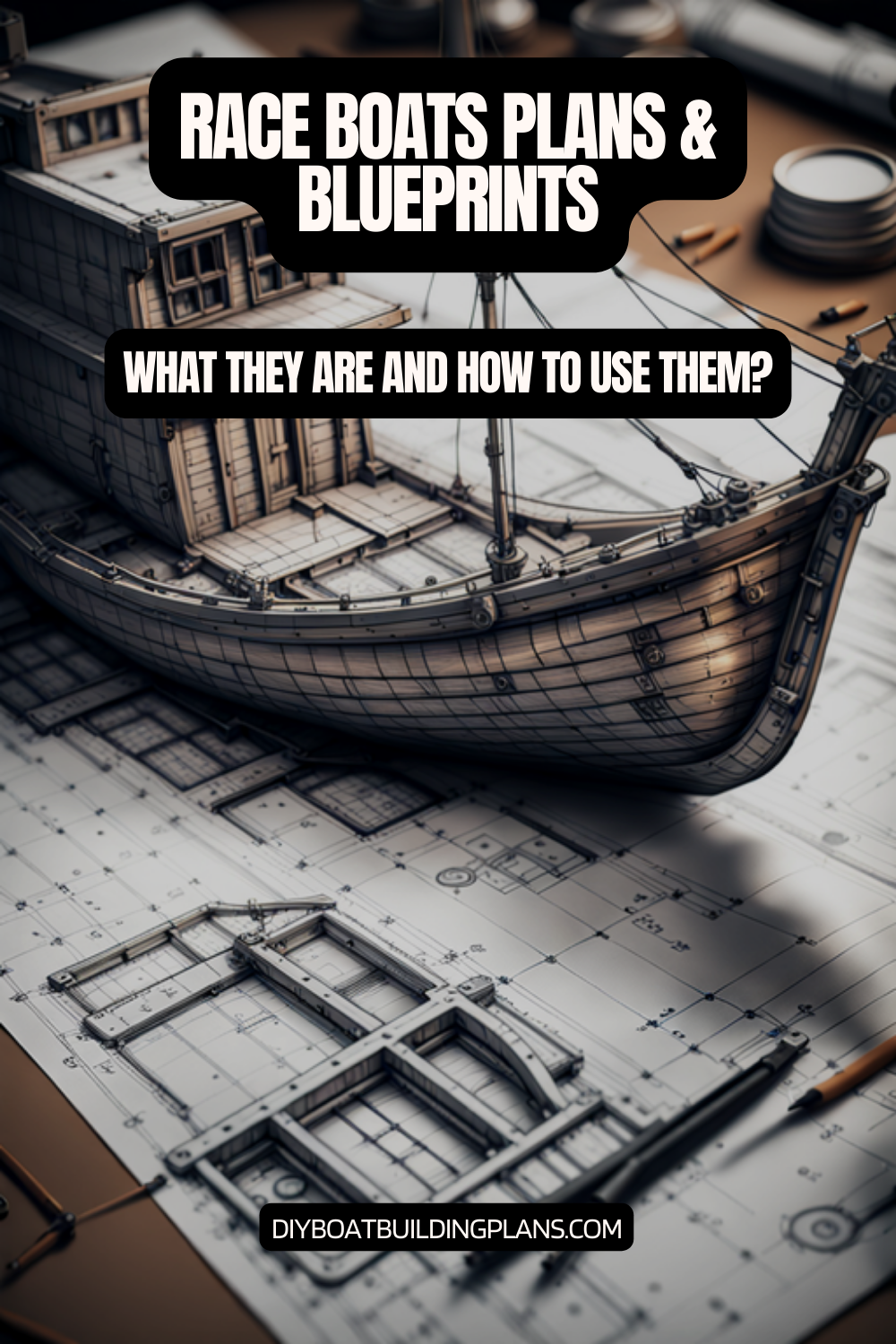Ever dreamed of building a super-fast racing boat yourself? What if the secret to making it fast was in a set of detailed blueprints?
DIY race boat plans and blueprints are your guide to making your boat-building dreams come true. They’re perfect for anyone who loves boats, whether you’re a weekend hobbyist or a future marine engineer. These guides lead you into the exciting world of boat design and building.
Building a boat like a hydroplane or catamaran is a thrilling challenge. Boatbuilding kits and blueprints give you the basics to turn materials into a speedy boat. Your creation will cut through water with ease and power.
Key Takeaways – Race Boat Plans & Blueprints
- DIY race boat plans offer a structured approach to boat construction
- Multiple boat designs are available for different skill levels
- Proper blueprints are key for successful boat building
- Affordable options exist for boat design plans
- Building your own boat combines technical skill with creative passion

Introduction to DIY Race Boat Plans
Starting a DIY race boat project is thrilling and creative. It lets you turn your plans into a unique watercraft. This shows your passion and skill.
To build a race boat, you need to plan well and know design basics. Wooden boat blueprints are key. They help you build a boat that matches your dreams.
Understanding the Basics of Race Boats
Race boats need careful engineering and detail. Important things to think about include:
- Water displacement calculations
- Hull design and structural integrity
- Weight distribution
- Material selection
“A well-designed boat is 60% science and 40% passion” – Professional Boat Builder
Benefits of Building Your Own Race Boat
Building your own race boat has many benefits:
- Cost-effective alternative to purchasing
- Complete customization options
- Personal satisfaction of creating something unique
- Deep understanding of boat mechanics
Building a race boat means learning about important design elements. For example, 60 pounds can displace about 1 cubic foot of water. This is key for figuring out boat size and how it performs.
Essential Tools and Materials
Starting a DIY race boat project needs careful planning and the right tools. Choosing top-notch tools and materials is key for a successful build. This ensures your boat meets high-performance standards.
Must-Have Tools for Precision Boat Construction
Building a race boat requires specific tools for accuracy and quality. Experts suggest using these essential tools:
- Measuring tools: Tape measures, set squares, and carpenter’s bevels
- Cutting tools: Japanese crosscut saws, jig saws, and utility knives
- Shaping tools: Chisels, planes, and spoke shaves
- Power tools: Drills, random orbital sanders, and grinders
- Fastening tools: Hammers, pliers, and multiple clamps
“The right tools can make the difference between a good boat and a great one.” – Professional Boat Builder
Recommended Materials for Durability and Performance
Choosing the right materials is vital for making fiberglass boat molds and meeting racing boat specs. Each construction method needs specific materials:
| Construction Method | Recommended Materials | Best For |
|---|---|---|
| Carvel Construction | Marine-grade plywood, white pine stringers | Traditional hull designs |
| Skin-on-Frame | Lightweight composites | Kayaks and small racing boats |
| Fiberglass Molding | High-strength composite materials | High-performance racing boats |
Your material choice affects the boat’s weight, strength, and performance. Invest in quality materials to ensure your race boat meets professional standards.
Step-by-Step Guide to DIY Race Boat Construction
Starting a DIY race boat project needs careful planning and precision. Building your own race boat is a thrilling mix of technical skills and creative passion. This guide will help you through the key steps of boat building, turning your DIY plans into a real boat.
Preparing Your Workspace
Before starting boat construction, setting up the right workspace is key. Your area should be:
- Well-ventilated and dry
- Big enough for boat construction guides
- Well-lit
- Organized with all the tools and materials you need
“A well-prepared workspace is half the battle in successful boat building.” – Professional Boat Builder
Following the Blueprint: A Detailed Approach
Following DIY race boat plans closely is essential. Break your boat construction into easy-to-manage stages:
- Thoroughly review boat construction guides
- Get your materials and tools ready
- Cut materials exactly as the plans say
- Put together the hull parts step by step
- Check your measurements and make sure everything is aligned
Common Challenges and How to Overcome Them
Building a race boat has its own set of challenges for DIY fans. Here are some key strategies:
- Weight distribution: Use precise measurements and balanced construction techniques
- Keep the structure strong by choosing the right materials
- Ask experienced builders for help with tricky technical parts
With patience and focus on details, your DIY race boat plans can turn into a stunning watercraft. It will show off your skill and hard work.
Types of Race Boats You Can Build
Exploring race boat design is exciting for DIY fans. Each boat type brings its own challenges and thrills. Builders can create high-performance boats that match their skills and racing dreams.
Race boat lovers have many choices for their next project. Knowing the details of different racing boat specs helps pick the right boat for your goals.
Popular Race Boat Designs
- Hydroplanes: Sleek, high-speed vessels designed for flat water racing
- Offshore Powerboats: Robust boats built for challenging maritime conditions
- Sailboats: Versatile craft requiring advanced sailing skills
Selecting Your Ideal Boat Design
Choosing the right boat design depends on several key factors:
- Your current skill level
- Intended racing class
- Available resources and budget
“The perfect race boat is the one that matches your passion and skill level” – Anonymous Boat Builder
| Boat Type | Skill Level | Recommended For |
|---|---|---|
| OzRacer | Beginner | Solo and Dual Sailing |
| Mini Vee | Intermediate | Racing Performance |
| Offshore Powerboat | Advanced | Competitive Racing |
The OzRacer is great for beginners. It’s lightweight and versatile, making it a good starting point for new builders.
Success in building race boats comes from research, skill building, and a love for boat making.
Unlock the secrets to building your dream boat with MyBoatPlans! With detailed plans for over 518 boats and expert video tutorials, you’ll have everything you need to create your perfect vessel. Click here to begin your journey!
Safety Considerations
When starting a boat project, safety is key. Homemade boat plans need careful safety steps. This ensures a safe build and a great boat.
Boat building comes with risks. Knowing the safety basics makes the project safer and more fun.
Essential Safety Gear for Boat Construction
- Impact-resistant safety glasses
- Heavy-duty work gloves
- Respiratory protection masks
- Steel-toed work boots
- Protective ear coverage
Safe Practices During Boat Construction
Professional builders stress the importance of safety. Keeping a clean workspace and following a plan helps avoid accidents.
“Safety isn’t expensive, it’s priceless.” – Unknown Boat Builder
When working on your boat, keep your area tidy. Make sure you have good air when using chemicals. Always have first-aid nearby.
Critical Safety Inspection Points
- Check structural integrity of materials
- Verify tool maintenance and condition
- Inspect protective equipment regularly
- Follow manufacturer guidelines for tools and materials
- Conduct thorough pre-launch safety checks
Building a boat is about skill and safety. Focus on safety to make a boat that’s safe and amazing.
Customizing Your Race Boat
Turning your DIY race boat into a unique powerhouse needs creativity and smart changes. High-performance boat designs need careful thought when adding custom touches. These should boost both looks and function.
Personalizing your racing boat involves several key steps. These can make your vessel truly stand out:
- Select unique color schemes that reflect your personality
- Integrate custom graphic designs or racing decals
- Choose specialized paint technologies for durability
Performance Enhancement Strategies
DIY Race Boat Plans & Blueprints offer chances for strategic upgrades. Experienced builders suggest focusing on areas that boost speed and handling.
- Experiment with advanced propeller configurations
- Add lifting strakes to sponson pads
- Optimize weight distribution for improved stability
Customization Considerations
When modifying your race boat, balance looks with performance needs. Careful engineering ensures your customizations genuinely improve boat capabilities.
Professional racers know that intelligent customization separates good boats from great ones.
| Customization Area | Performance Impact | Difficulty Level |
|---|---|---|
| Propeller Upgrade | High | Moderate |
| Hull Modifications | Very High | Advanced |
| Color/Graphics | Low | Easy |
Remember, any changes must follow specific racing class rules. This ensures you can compete.
Download over 500 Boat Plans. Click on the link below.
-->Click Here<--
Maintenance Tips for Your Race Boat
Keeping your race boat in top shape is key for the best performance and long life. Boat building fans know that regular care can make a big difference. Whether you used wooden boat blueprints or kits, taking good care is vital.
Knowing the right maintenance routine is important. It helps protect your investment and keeps your boat ready to race.
Regular Maintenance Routines
A good maintenance plan has three main parts:
- Preseason preparation
- Mid-season check-ups
- Post-season preservation
Important areas to check include:
- Hull integrity
- Rigging tension
- Electronic systems
- Engine performance
Troubleshooting Common Issues
Race boat owners should have a plan for fixing problems. Preventative maintenance is always better than reactive repairs.
“A well-maintained boat is a fast boat” – Professional Racing Team Manager
Here are some maintenance tips:
- Rinse boat after each use to remove salt and debris
- Check rigging settings after every sailing day
- Photograph sails periodically to assess condition
- Create a pre-sail checklist for critical systems
By following these tips, you’ll get the most out of your race boat. You’ll also make it last longer in competitions.
Cost Breakdown of Building a Race Boat
Starting a DIY race boat project needs careful money planning. By planning smart, you can save a lot. This makes your dream of a custom race boat possible.
Budgeting for Your Project
Understanding the costs is key when building a boat. DIY kits can save you 40% to 50% compared to buying a boat.
- Initial design plans: $55-$65 for detailed blueprints
- Material costs: Varies with boat size and complexity
- Tool investments: Needed for building
- Potential modifications: Plan for performance upgrades
Finding Affordable Materials
Choosing the right materials can cut costs. Here are some tips:
- Use exterior-grade plywood for savings
- Buy kit-plan packages for all you need
- Look for bulk material discounts
- Consider second-hand tools
“The key to successful DIY race boat construction is smart budgeting and strategic material selection.”
Comprehensive kit-plan packages include over 50 detailed drawings. They help you manage costs and navigate complex builds.
Boat building takes time, energy, and skill. While it’s an investment, the joy of creating your own race boat is worth it.
Joining a Community or Club
Building a race boat can be thrilling, but it’s even better with friends. Connecting with others turns your project into a fun, shared journey. You’ll learn and create together.
Boat design and construction have passionate communities ready to share. Whether you’re new or experienced, joining a network offers great resources and friends.
Benefits of Sharing Knowledge
- Get expert advice and tips
- Meet experienced boat builders
- Learn new design techniques
- Find chances to work together
“In boat building, shared knowledge is the wind that fills your sails.” – Anonymous Boat Builder
How to Find Local Boat-Building Groups
- Look for community boards at marine stores
- Search online forums for boat building
- Connect with groups like the American Power Boat Association (APBA)
- Go to boat shows and maritime festivals
- Join social media groups for boat building
Tip: Local sailing clubs and maritime museums often host workshops and events perfect for networking with boat building enthusiasts.
Your boat-building journey becomes richer when you share experiences, learn from others, and build connections that extend beyond your workshop.

Conclusion: Start Your DIY Journey
Starting a DIY race boat project is exciting. It combines craftsmanship and marine engineering. With DIY Race Boat Plans & Blueprints, you can turn your passion into a real boat.
Building a race boat is more than a hobby. It’s an art that tests your skills in design and construction. It’s a chance to show off your creativity.
Creating your own race boat takes hard work, patience, and a desire to learn. You can explore different designs, like planing hulls or V-hulls. Beginners can start with simple models and get better with each project.
Encouragement to Begin Your Project
Your first race boat might not be perfect, but it’s a big step. You can find help in marine forums, workshops, and online groups. Remember, every expert was once a beginner.
Resources for Further Learning
Keep learning with marine design books, online tutorials, and workshops. The American Power Boat Association (APBA) has great resources for boat builders. Your boat-building journey is only limited by your dreams and how much you’re willing to learn.
FAQ – Race Boat Plans & Blueprints
What are the key considerations when choosing race boat plans?
When picking race boat plans, think about weight, hydrodynamics, and how strong it is. Also, consider your skill level and the racing class rules. Look for plans with clear instructions, diagrams, and safety tips. The best plan should fit your building skills and racing goals.
What materials do I need to build a race boat?
You’ll need marine or exterior-grade plywood, white pine for stringers, and composite materials for strong areas. Tools like measuring tape, saws, and drills are also needed. Marine plywood is better for performance, but exterior-grade can save money.
How much does it cost to build a DIY race boat?
Costs vary based on design and materials. Plans cost $55-$65, plus money for tools, materials, safety gear, and the engine. Using exterior-grade plywood can cut costs. Plan for extra expenses for upgrades to boost performance.
What are some popular race boat designs for beginners?
Beginners might like the Mini Vee or the Dillon Sport C tunnelboat. These designs are easy to build and great for new builders. They’re perfect for starting in racing competitions.
What safety precautions should I take when building a race boat?
Safety is key when building a race boat. Follow APBA safety rules, wear proper gear, and make sure it’s strong. Add features like hydraulic trim for better control. Regular checks and following safety guidelines are vital.
Can I customize my race boat’s design?
Yes, you can customize your boat! You can change colors, add performance upgrades, and adjust weight. But, make sure changes follow racing rules and don’t harm the boat’s safety or strength.
Where can I find support and resources for building a race boat?
Look for support in boat-building communities like the APBA, online forums, and local clubs. These places offer advice, tips, and chances to share with other builders. Talking to experienced builders can help you solve problems and get better at building.
What maintenance is required for a race boat?
Keep your boat in top shape with regular checks. Look for damage, check the engine, and make sure safety gear works. Fix any structural problems quickly and be ready to make changes based on racing. Keeping up with maintenance is essential for performance and longevity.



